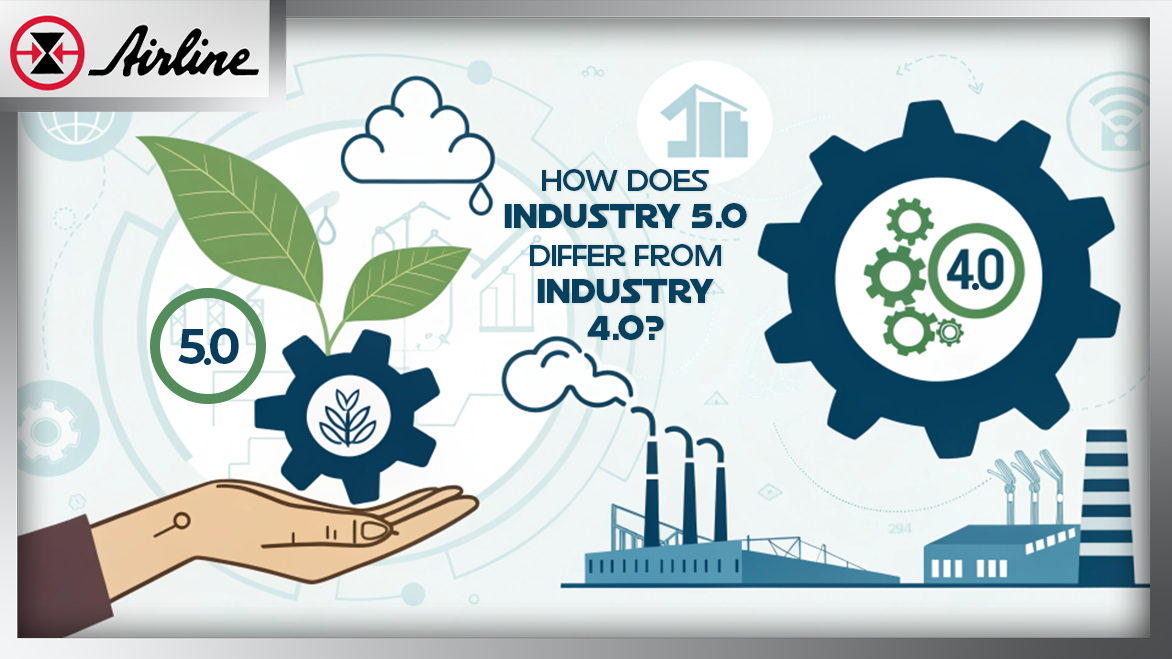Last year, we kicked things off by diving into Industry 4.0 and the technologies that practically pay for themselves. This year? We’re singing a similar tune but with a twist—Industry 5.0. So, what’s the difference?
Industry 5.0 is shaping up to be one of the most exciting trends of 2025. It’s the next step in manufacturing’s evolution, where cutting-edge tech like AI and robotics meet human creativity and sustainability. While Industry 4.0 focuses on automation and efficiency, Industry 5.0 is all about prioritizing human-centric design and sustainability, with an emphasis on collaboration and a greener future.
In this post, we’ll break down the key differences between Industry 4.0 and Industry 5.0, explore the technologies making it possible, and look at how it’s set to transform industries across the board. Let’s dive in!
In This Blog Post
Key Differences Between Industry 4.0 and Industry 5.0 | Core Principles of Industry 5.0 | Technologies Driving Industry 5.0 | Applications of Industry 5.0 Across Sectors | Challenges and Future Directions | Embracing Industry 5.0 | Frequently Asked Questions
Ready To Embrace Industry 5.0? Contact us for a consultation TODAY!
Key TakeawaysHuman-Centric Collaboration: Industry 5.0 emphasizes collaboration between humans and machines, enhancing job satisfaction and sustainability. Advanced Technologies: Core technologies include AI, machine learning, digital twins, and collaborative robots. Challenges: Transitioning to Industry 5.0 requires addressing skill gaps, cybersecurity concerns, and operational complexity. |
Key Differences Between Industry 4.0 and Industry 5.0
.png?width=335&height=252&name=two-gears-interlocking--with-one-representing-tech%20(2).png)
The transition from Industry 4.0 to Industry 5.0 marks a significant shift in the manufacturing landscape. While Industry 4.0 focused primarily on automation and efficiency, Industry 5.0 places a greater emphasis on human-centric solutions and sustainability. This shift reflects a broader understanding of the importance of human well-being and environmental sustainability in industrial production.
One of the key differences between Industry 4.0 and Industry 5.0 is the focus on human involvement in the manufacturing process. Industry 5.0 advocates for a cooperative relationship between human workers and intelligent machines, enhancing productivity and job satisfaction. This approach not only improves the efficiency of production processes but also fosters a more engaged and creative workforce.
Industry 5.0 enhances the digital backbone of Industry 4.0 with empathy, creativity, and ecological awareness. The outcome is an industrial ecosystem that values connectivity and optimization without sacrificing human comfort or environmental health. This integrated approach produces resilient organizations ready to thrive amid shifting regulations, consumer expectations, and resource limitations.
Key Differences Between Industry 4.0 and Industry 5.0
|
Aspect |
Industry 4.0 |
Industry 5.0 |
|
Focus |
Automation and Efficiency |
Human-Centric Design and Sustainability |
|
Role of Humans |
Limited to Supervisory Roles |
Central to Collaboration and Creativity |
|
Technology Usage |
Data-Driven Automation |
AI-Enhanced Human-Machine Interaction |
|
Sustainability |
Secondary Focus |
Primary Goal |
Core Principles of Industry 5.0
 At the heart of Industry 5.0 is a human-centric approach that integrates human values into industrial production. Industry 5.0 focuses on creating a more personalized and empathetic working environment, emphasizing the value of human workers. This approach not only enhances job satisfaction but also fosters creativity and critical thinking—key drivers of innovation in the manufacturing industry. Let's review the core principles of Industry 5.0 to better understand how it differs from Industry 4.0.
At the heart of Industry 5.0 is a human-centric approach that integrates human values into industrial production. Industry 5.0 focuses on creating a more personalized and empathetic working environment, emphasizing the value of human workers. This approach not only enhances job satisfaction but also fosters creativity and critical thinking—key drivers of innovation in the manufacturing industry. Let's review the core principles of Industry 5.0 to better understand how it differs from Industry 4.0.
Human-Centric Design
Human-centric design is a cornerstone of Industry 5.0, ensuring that technology enhances rather than replaces human roles in industrial processes. This approach prioritizes the needs and interests of human workers, creating a more intuitive and engaging work environment that celebrates the human touch. By leveraging cognitive computing technologies and systems engineering, Industry 5.0 fosters workplaces where humans and machines collaborate seamlessly.
Key Principles of Human-Centric Design:
Seamless Human-Machine Interaction: Robots and AI take on repetitive and mundane tasks, freeing human workers to focus on creativity and critical thinking. Advanced technologies like sensors, actuators, and machine learning enable robots to work alongside humans, boosting productivity and job satisfaction.
Ergonomic Workplaces: Production processes are designed with human comfort and engagement in mind, ensuring a healthier and more motivating work environment.
Ethical Leadership: Businesses embed empathy into their strategies, fostering employee satisfaction, innovation, and a stronger sense of purpose.
For businesses transitioning to Industry 5.0, adopting human-centric values is essential. Empathy-driven leadership and ethical practices enhance workforce engagement and creativity, leading to long-term benefits such as increased employee satisfaction, loyalty, and improved business performance. Additionally, this approach positively impacts customer satisfaction by ensuring the workforce is motivated to deliver their best work.
Sustainability in Industry 5.0

Sustainability is a fundamental principle of Industry 5.0, focusing on reducing the environmental impact of industrial production by adopting sustainable practices and minimizing waste. By integrating advanced technologies, Industry 5.0 creates a more resource-efficient and environmentally friendly industry.
Key Strategies for Sustainability:
Circular Economy Practices: Recycling and reusing materials extend product lifecycles, emphasizing resource conservation and reducing waste.
Energy Management: Smart machines and energy-efficient technologies minimize energy waste, improving production efficiency while reducing environmental impact.
Resource Optimization: AI and machine learning streamline processes, reducing waste and enhancing energy use.
Industry 5.0’s commitment to sustainability enhances production efficiency while contributing to the planet's well-being. These practices not only conserve resources but also align industrial growth with environmental stewardship, ensuring a sustainable future.
Technologies Driving Industry 5.0
.png?width=474&height=237&name=technologies-driving-industry-5-0%20(1).png)
The transformation to Industry 5.0 is driven by a suite of advanced technologies that enable seamless collaboration between humans and machines.
Key enabling technologies consist of various components, including:
Cloud Computing: Used by 94% of enterprises globally, cloud computing allows manufacturers to predict machine failures, optimize production processes, and monitor operations in real-time. The global cloud computing market is projected to grow from $445.3 billion in 2021 to $947.3 billion by 2026, at a compound annual growth rate (CAGR) of 16.3% (Source: Zippia).
For example, Rolls-Royce employs cloud computing for predictive maintenance, significantly reducing engine downtime.
Blockchain: Ensures data security and transparency, particularly in supply chain management, reducing fraud and enhancing trust. Blockchain technology is instrumental in enhancing transparency, security, and efficiency in supply chain management within the manufacturing industry (Source: LA Blockchain Summit).
Big Data Analytics: Big data analytics is a key driver of innovation in manufacturing, enabling advanced algorithms to optimize production quality and operational efficiency. This growing field is projected to expand significantly, with the global big data in manufacturing market increasing from $3.22 billion in 2018 to $21.51 billion by 2032, at a CAGR of 12.6% (Source: Fortune Business Insights).
The Internet of Things (IoT): IoT enables smart factories to enhance energy efficiency and optimize production processes. For example, Bosch’s IoT-enabled Energy Platform helped its lead plant in Homburg, Germany, achieve a 12% reduction in CO₂ emissions within the first two years by connecting over 10,000 data points. This demonstrates how IoT solutions can support sustainability in manufacturing (Source: Bosch).
Globally, the IoT market is projected to grow from $300.3 billion in 2021 to $650.5 billion by 2026, at a compound annual growth rate (CAGR) of 16.7% (Source: Yahoo Finance).
6G Networks: While still emerging, 6G promises data transmission speeds up to 100 times faster than 5G, enabling unprecedented real-time communication and control. It is anticipated to offer data transmission speeds up to 1,000 gigabits per second (Source: TT Consultants).
These technologies collectively support the creation of smart factories where production processes are optimized in real-time, enhancing both efficiency and sustainability. They also create competitive advantages by integrating human and machine capabilities seamlessly, fostering resilience and adaptability in the manufacturing industry.
|
Ready to take the next step toward integrating Industry 5.0 technologies into your operations? Book a meeting with Airline's Product Sales Manager/Application Engineer, Harrison Williams, to discuss your application's automation opportunities. |
Applications of Industry 5.0 Across Sectors

Industry 5.0 is revolutionizing industries by merging advanced technologies with human-centric solutions, enhancing customer satisfaction and operational efficiency. Some of the key applications of Industry 5.0 include;
Smart Manufacturing: Industry 5.0 integrates digital twins, AI, and cobots to enhance production efficiency and responsiveness. Real-time monitoring and simulation optimize operations, align processes with customer demands, and reduce waste. These innovations create sustainable and adaptive production lines, meeting both environmental and market needs.
Healthcare Innovations: Personalized healthcare solutions, such as smart devices for Type-1 diabetes management, improve patient outcomes. By integrating human insights into workflows, Industry 5.0 ensures healthcare systems are tailored, efficient, and responsive to patient needs.
Sustainable Supply Chains: Advanced technologies like cobots, blockchain, and big data analytics transform supply chains. Blockchain enhances transparency and security, while AI-driven analytics forecast demand and optimize resources. These innovations reduce risks, waste, and environmental impact, creating resilient and sustainable supply chains.
Industry 5.0 empowers businesses to adapt to evolving market demands and environmental challenges, driving innovation and sustainability across sectors.
Challenges and Future Directions

Despite its benefits, transitioning to Industry 5.0 presents some challenges, such as security concerns, skill gaps, lengthy processes, and significant budget requirements. Yet, to remain competitive, manufacturers must prioritize sustainability, collaboration, and workforce upskilling. Here are some tips to overcome these challenges.
Overcoming Skill Gaps
Addressing skill gaps is critical for Industry 5.0 adoption. Proper training enables employees to collaborate effectively with advanced technologies like AI and cobots. Upskilling programs using AR and VR can help workers enhance human-centric skills, ensuring they remain competitive in increasingly automated environments. Continuous learning fosters effective human-machine collaboration, boosting productivity and innovation.
Tip: Invest in immersive training tools and partnerships with educational institutions to ensure your workforce is future-ready.
Addressing Security Concerns
As interconnected technologies increase operational efficiency, they also heighten cybersecurity risks. Manufacturers must adopt proactive measures, such as regular assessments, updates, and employee training, to safeguard data and operations. Robust cybersecurity strategies ensure resilience against evolving threats, protecting both systems and valuable assets.
Tip: Establish a cybersecurity roadmap and ensure all employees are trained to recognize threats.
Future Research Areas
Future research in Industry 5.0 focuses on advanced technologies like AI, digital twins, and quantum computing, which enable real-time decision-making, accurate simulations, and enhanced efficiency. Improving human-machine interaction is another priority, fostering intuitive work environments that enhance productivity and job satisfaction.
Ongoing innovation and exploration of emerging technologies are essential for creating a sustainable, adaptive, and resilient manufacturing industry that meets the evolving needs of workers and customers.
Tip: Allocate research and development resources to evaluate how emerging technologies align with your business goals
Embracing Industry 5.0
Industry 5.0 marks a pivotal evolution in manufacturing, emphasizing human-centric design, sustainability, and cutting-edge technologies. By integrating AI and collaborative robots, it boosts productivity while prioritizing worker well-being and environmental safety. This shift from Industry 4.0 highlights the importance of human involvement and eco-friendly practices in modern production.

Need help implementing Industry 5.0 technology? We're here to help!
|
Additional Resources
- Contact us for a consultation TODAY!
- Shop Technologies
- Source: Zippia
- Source: LA Blockchain Summit
- Source: Fortune Business Insights
- Source: Bosch
- Source: Yahoo Finance
- Source: TT Consultants







Leave Comment